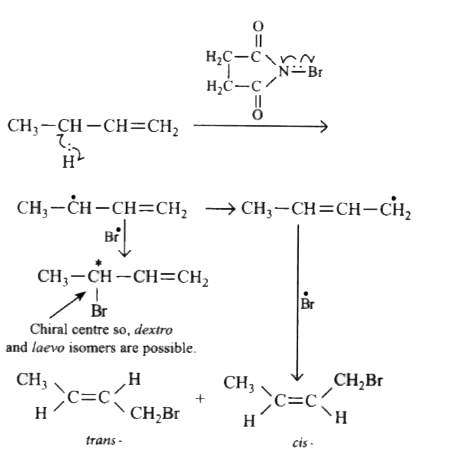The number of possible organobromine compounds which can be obtained in the allylic bromination of 1-butene with N-bromosuccinimide is
A
1
B
2
C
3
D
4
Text Solution
The correct Answer is:D
NBS (N-Bromosuccinimide) does allylic bromination through free radical substitution.

∴ Total 4 isomers are possible.
|
Topper's Solved these Questions
- HALOALKANESBOOK - MTG-WBJEECHAPTER - HALOALKANESEXERCISE - WB JEE Previous Years Questions (CATEGORY 3 : One or More than One Option Correct Type ( 2 Marks)
1 Videos
- HALOALKANESBOOK - MTG-WBJEECHAPTER - HALOALKANESEXERCISE - WB JEE Previous Years Questions (CATEGORY 1 : Single Option Correct Type (1 Mark)
2 Videos
- ENVIRONMENTAL CHEMISTRY BOOK - MTG-WBJEECHAPTER - ENVIRONMENTAL CHEMISTRY EXERCISE - WB JEE Previous Years Questions ( CATEGORY 1 : Single Option Correct Type )
2 Videos
- HYDROGENBOOK - MTG-WBJEECHAPTER - HYDROGENEXERCISE - WB JEE PREVIOUS YEARS QUESTIONS
2 Videos
Similar Questions
Knowledge Check
The number of σ bond in 1-butene is
A8B10C11D12The number of steroisomers obtained by the bromination of trans-2-butene is:
A3B2C1D4The number of stereoisomers obtained by bromination of trans-2-butene is
A1B2C3D4
The number of stereoisomers obtained by bromination of trans-2-butene is :
View SolutionWhich compound is a possible product from addition of Br2 to 1-butene?
View SolutionThe maximum number of isomers that can result from monobromination of 2-methyl-2-pentene with N bromosuccinimide in boilingCCl4 is
View SolutionThe number of stereoisomers obtained by bromination of trans-2-butane is
View SolutionAldehyde can be obtained by the oxidation of which of the following compound.
View Solution
